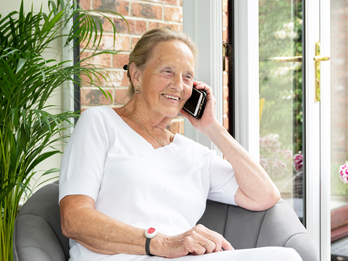
The move from analogue to digital systems is at a pivotal time. Providers must not only consider which technology to invest in and how, but the impact of new systems upon ways of working and the potential for improved partnerships across health and social care.
Telecare is an enabler that helps us think differently about the way we support people, delaying or preventing the need for more complex/expensive solutions or hospital admission. Digital telecare solutions enable us to be more proactive, reducing access to primary, secondary and social care in many cases. Through connecting multiple devices and generating data and intelligence, we can gather actionable insights that maximise the opportunities that digital solutions present for both providers and citizens.
Good progress is being made by telecare services across the UK. We’ve given a snapshot of some of these below, sharing the experiences of providers, demonstrating the value of digital, data and technology and evidencing why the Government should support investment in digital transformation.
Sefton Careline, which supports 5,500 people, is reshaping its telecare service using digital solutions and smarter workflows to increase capacity and sustainability. Jo Alty, Sefton Careline Manager says, “Going on to a digital platform has made things a lot more flexible, a lot more achievable because we’re not hitting the barriers we would with an analogue service”.
Sue and Heather are Careline Administrators. Sue advises that part of their job at Sefton Careline is to get people out of hospital quickly with telecare equipment being installed within 48 hours of discharge as there is often limited or no support at home. Heather comments that “some hospital discharge referrals have ‘dependent on installation of the Lifeline’ [written] on them which means that hospital discharge is dependent on us.”
Jo continues “Tunstall’s digital platform has changed the whole service for the team in terms of agility, resilience and everything really.”

Steve Moore is Team Leader at Reach and Respond Monitoring Centre which took 133,000 calls last year from residents at Beyond Housing advises, “The next step is to look at how we can use interactive and digital technology to take things forward. [The telecare service] is taking pressure away from the Ambulance Service, from social care and keeping customers independent in their own homes. It’s just doing what we want it to do and what we need it to do to reduce admissions, to keep people independent and to support them. It’s that simple.”
Ian Jackson, Careline Team Leader at Newark and Sherwood District Council (NSDC) which supports around 2,000 residents suggests that the biggest risk [for NSDC] was transitioning to digital. “Providers should focus on various aspects of technology enabled care such as wearable options for different aspects of normal daily life such as hydration or smart watches. It’s a growing market and there’s a growing need for the market to change alongside the digital transition.”
Watch Ian's full video and hear what other customers have to say here

Clive Taylor, Housing Assets and Support Team Manager at Hinckley and Bosworth Council states that “The digital network will have a massive positive impact on our service, making it more flexible and tailored to meeting our residents’ needs.”
Watch Clive's full video and hear what other customres have to say here
Citywide Care Alarms (CWCA) in Sheffield supports 8,200 people on behalf of Sheffield City Council. Tunstall Response (a community Alarm Receiving Centre) and CWCA work together to identify frequent callers, raising any safeguarding concerns and signposting to other services. Tunstall also manage CWCA’s Responder Service. meaning that when appropriate, a responder can be mobilised within 45 minutes, reducing the potential need for an ambulance call out. Monthly reporting identifies any changes in service user behaviour, such as an increase or decrease in alarm calls, that may indicate a cause for concern which can then be addressed.
CWCA plans to grow the service in future, working closely with colleagues in social care and housing to include technology in strategic planning to help more people in Sheffield benefit from the support and reassurance of the service.
Michelle, a service user’s daughter comments, “I would like to thank CWCA for all their hard work. My dad is at home due to health issues and has a CWCA alarm. I can honestly say as my dad’s wish is to be at home, CWCA allows this, as if he has a fall he can press his pendant for help. When he has asked for assistance, the team are truly amazing from the first call. The team who attend treat my dad with respect and kindness and make sure he is safe. Karen called me today and showed kindness and empathy to the situation and most of all support. I would like to thank every single person who is part of the team as you go above and beyond in your job.”
View the full case study with Sheffield Council and City Wide Alarms
Shirley Hall, former Head of Care and Wellbeing at Retirement Villages Group who manage 16 villages for older people with an average age of 86 advises “We need to shape things and work on things together whilst thinking about what the future holds for older people and how we can design those products together. We’re all using our own devices, smart phones and tablets, so how can they produce products that fit with that, where residents can use their own device, easily download an app and link it to a product? We need to work with providers to design future products and services because [residents] always tell us what works well and what doesn’t work well.”
Watch Shirley's full video and hear what other customrs have to say

Andrea Boughey, Senior Commissioner at St Helens Council and Sarah Houghton-Grimshaw, Supported Housing Commissioning Office at Torus, the North West’s largest affordable housing provider, sum up the importance of working together to provide digital solutions.
There is a lack of appropriate housing for people with a learning disability or autism who may have behaviours that challenge. Alexander Court in St Helens is an existing purpose-built property with independent living and sheltered housing elements, plus a care home which had become unoccupied. St Helens Council, Torus and NHS England worked together to plan a major remodelling to transform the care home into Heathside, a specialist accommodation facility with eight assisted living apartments for adults with learning disabilities and autism.
Heathside has specialised technology including Tunstall telecare systems, fire panels, door locking and ligature alarm systems. It will be home to people who have previously required supported living services outside of the St Helen’s borough or have been waiting to be discharged from hospital. Andrea comments that “[the building] has [also] been designed to avoid admission to hospital because there is a higher intensity of support with staff 24 hours a day and all of the technology that may be able to prevent someone from being in that position in the future.”
The vision for the building is that it will be adapted over time as resident’s needs change. This will be delivered by the Council, Torus, Tunstall and “our end customer, the NHS” working together to deliver future-proofed solutions.

In conclusion, the analogue to digital transition is a huge practical opportunity to bring telecare and other technology solutions together; to work better together, in partnership with organisations such as local authorities, the NHS and housing associations to deliver integrated solutions and services to improve the care and wellbeing and outcomes of citizens.
Find out more about how Tunstall can help you through the digital transition



